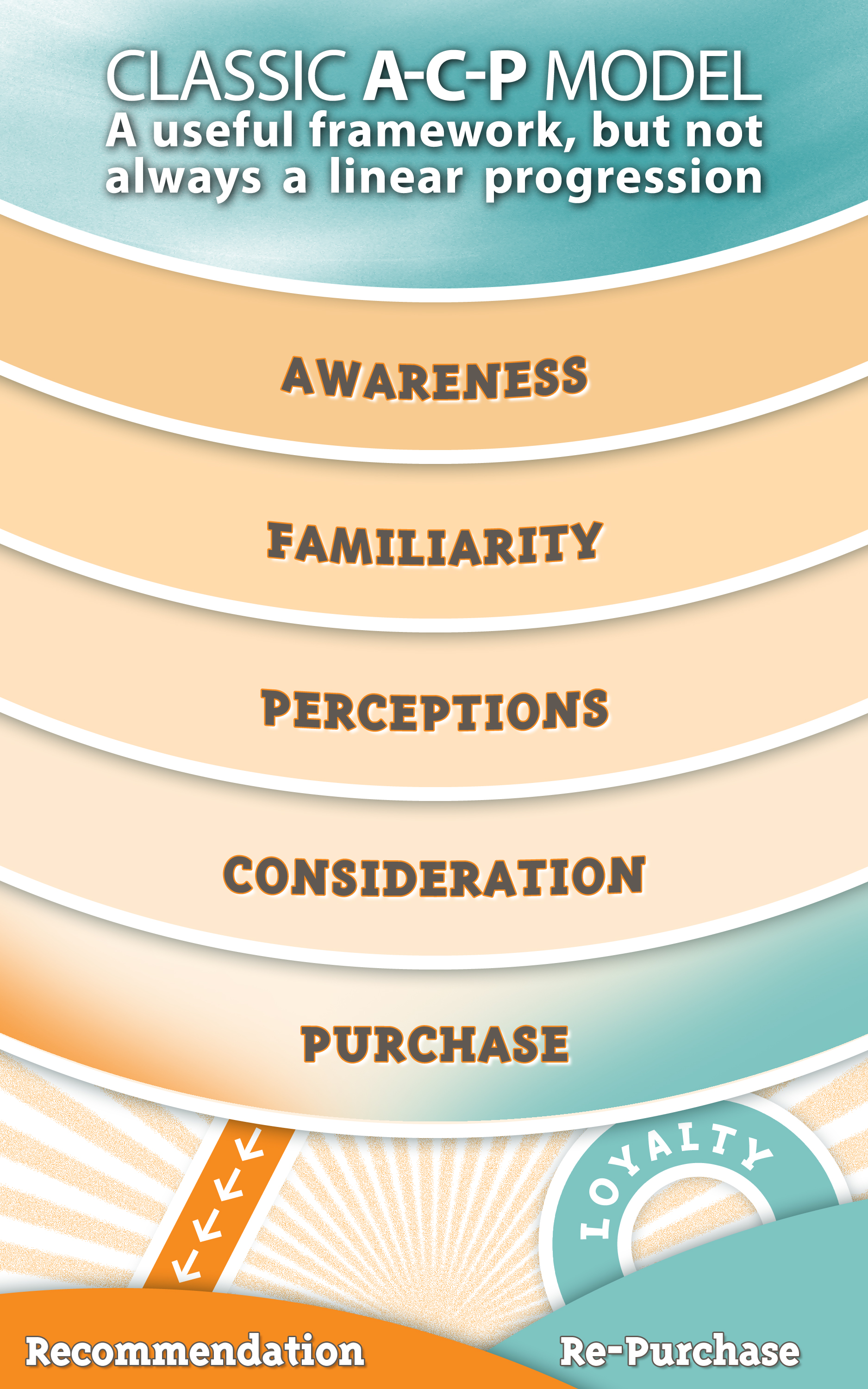Technology Brand Positioning: Evolution of Process
By Andrew Elder, SVP Marketing Sciences
Download PDF

In order to effectively market itself, a brand must navigate multiple levels of engagement. The classic Awareness–Consideration–Purchase (ACP) model provides a useful framework for evaluating the impact of branding at different stages of customer involvement. Yet customers seldom move along this path in a purely linear process, so brands must acknowledge that both customers and prospects are free to move forward and back along a continuum of engagement and are not always on the precipice of purchase.
Each stage carries unique challenges and objectives for the brand. In our years of researching technology categories, and particularly B2B markets, we have recognized some of the unique brand challenges that must be addressed during positioning research.
For technology brands, it isn’t just about the purchase
For many consumer products, there is very little learning that the consumer needs to go through prior to purchase. When products are clearly established, customers exist closer to the “Consideration” and “Purchase” end of the A-C-P spectrum by default: Lexus doesn’t need to educate customers about cars, nor does Coke need to explain the soft drink category to the marketplace. Thus many traditional consumer branding and marketing efforts focus on creating brand image and differentiating products, often based on the four P’s.
But in technology markets, the category itself is often in a constant state of evolution and consumers are constantly learning, so the brand must represent something beyond the products it is trying to sell. For instance, traditional telecom is as simple as ensuring your phone rings… but throughput tiers, bandwidth caps, telephony features, and technology convergence are only a sampling of issues that are constantly affecting what, and how, telecommunications providers sell.
Even a product as ubiquitous as media must grapple with technology branding. Any artist or studio attempting to market its product will invariably confront the transition from physical media to digital media, and ultimately to cloud. It is the platform, in tandem with the producer, that dictates how people engage and consume media. Traditional branding efforts that focus on awareness and affinity miss opportunities for platforms to help the consumer balance discovery, quality, accessibility, and engagement. These factors are evolving and highly individualized, creating distinct challenges for media marketers.
As technology evolves, so do technology brand perceptions
Such fluidity means that customers (both consumers and businesses) are often evaluating what they know about various technology markets, building and rebuilding their brand perceptions across the A-C-P spectrum. Dynamic technology markets require a brand to represent far more than just a product / price value proposition since products can be expected to change. Technology branding must also say something about the company’s ability to lead (or at least react to) changing markets, and even educate customers about evolving categories.
These characteristics have implications for brand messaging and positioning, since the larger impact of technology marketing comes in gaining entrance to the consideration set, perhaps by creating a viable product category. If a technology message is aimed or tested solely at the point of purchase it may come too late to drive the purchase process.
The evolution of tablet computers illustrates this phenomenon. For years, Microsoft and OEMs made tablet products that appealed to niche markets for digital artists or medical applications. Initial marketing efforts were uncertain, typically attempting to introduce the tablet concept within the familiar context of PC usage. With the introduction of the iPad, Apple almost instantly solidified the viability of the tablet, and competitors were forced to pivot their branding around Apple’s positioning. One brand was allowed to define the market, and the remaining competitors have struggled to react convincingly.
Technology branding lessons go beyond the product
Consider “Intel Inside” and “Mac vs. PC” brand positions; two of the most successful technology campaigns in history. Neither campaign directed customers to a specific product or attempted to differentiate brands based on specific features or prices. Rather, they illuminated the idea that a choice was available for processors or computers, and brought Intel and Apple into consideration. For Intel, it meant creating a category for processors that few knew existed, while Apple reinvigorated a choice most assumed had disappeared.
Imagine if these messages had been tested in a purchase context, alongside the tangible price/feature components we typically invoke in conjoint or related choice exercises. Would this have made any sense to a customer? Would we expect there to have been any influence from these campaigns without some thought to what each meant to the broader purchase context?
In conclusion…
When executing branding and positioning research for our technology clients, we work to reveal the specific positioning statements, proof points and attributes that will ultimately impact decision-makers through the entire process from Awareness to Consideration.
Ultimately the brand and brand positions must drive purchase, but at the point of purchase the product features and pricing become primary. The purchase decision itself warrants a distinct and rigorous research process, but the testing and validation of technology brand positioning requires focusing customers’ limited time and attention on the stages prior to purchase where positioning has the greatest effect.
———————————————————————————————————————
If you have additional questions about branding and positioning in the technology market, or want to learn how Illuminas can reveal the positioning that is best for YOUR brand, drop us a line at [email protected] or call us at (512)-652-2700.
